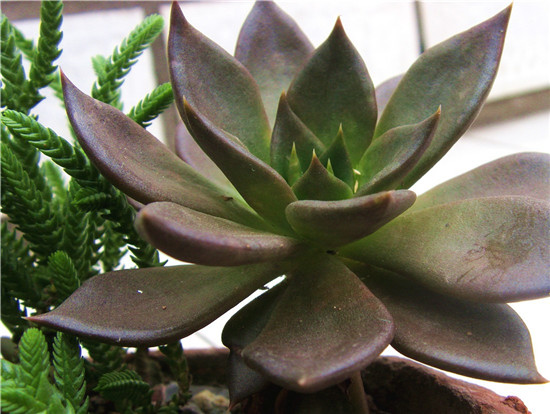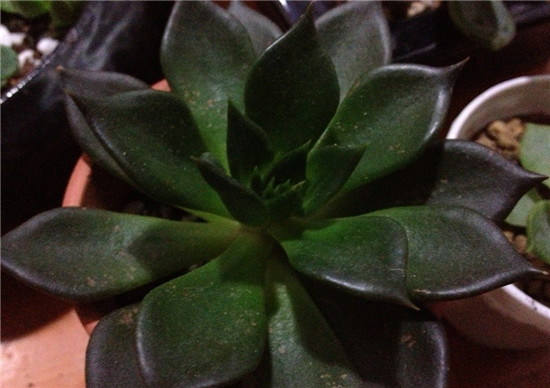[black Prince] how to maintain the black prince, a succulent plant
The Black Prince is a succulent plant and belongs to the genus Euphorbiaceae. Next, let's take a look at the maintenance of the succulent plant Black Prince.

The black prince plant has a short stalk, fleshy leaves arranged into a standard rosette, leaves spoon-shaped, slightly thicker, apical tip, black-purple leaves. Strong habits, although there is a short dormancy period in summer, but as long as a little shade, ventilation and water-saving is not difficult in summer. Early spring and autumn are prosperous periods of growth, and liquid fertilizer can be applied. The pot soil should not be too dry, otherwise the old leaves will wither and the general garden soil can be used for planting.
The shape of the rosette plant is the same as that of the common stone lotus. The spoon-shaped leaves are thicker. When the growth is exuberant, the upper leaves of the plant are more than 100, and the width of the plant is more than 20 cm. The leaves are dark purple and dark green near the growing point when the light is insufficient. It is a perennial succulent herb of the genus Elaeagnus of Sedum family. The plant has a short stalk, fleshy leaves arranged in a standard rosette, leaves spatulate, slightly thicker, apically pointed, leaves black and purple. The Black Prince's perfect rosette leaf plate and special leaf color make it highly ornamental and eye-catching. And it is easy to cultivate and breed, so it is a good product for family potted plants.

The Black Prince is a cultivated variety. The plant has a short stalk, fleshy leaves are arranged into a standard rosette-shaped, when the growth is exuberant, the diameter of the leaf disk can reach 20 meters, the leaf is spoon-shaped, slightly thick, the tip has a small tip, and the leaves are black and purple. Cymes, florets red or purplish red. The shape of the rosette plant is the same as that of the common stone lotus. The spoon-shaped leaves are thicker. When the growth is exuberant, the upper leaves of the plant are more than 100, and the width of the plant is more than 20 cm. The leaves are dark purple and dark green near the growing point when the light is insufficient.
Strong habits, although there is a short dormancy period in summer, but as long as a little shade, ventilation and water-saving is not difficult in summer. Early spring and autumn are prosperous periods of growth, and liquid fertilizer can be applied. The potted soil should not be too dry, or the old leaves will wither. General garden soil can be used for planting. Reproduction can cut the top to give birth to tiller buds, but also can be propagated by leaf insertion, and the success rate is much higher than that of ordinary stone lotus.

The mode of reproduction of the Black Prince
The reproduction of the Black Prince can be carried out by taking mature and complete leaves during the growth period and drying them for 1-2 days before insertion, tilting slightly or laying them flat on vermiculite or sandy soil, keeping a little damp, and will soon take root at the base and grow new buds, and so on, the new buds will grow a little bigger and become new plants; they can also be planted with young plants germinated next to the old plants, which are easy to survive.
Reproduction can cut the top to give birth to tiller buds, leaf insertion propagation of two methods, the success rate is much higher than the general stone lotus. The medium of insertion is an important part of survival. It is suggested that flower friends should make more efforts in the choice of media, and sand can be used if conditions do not permit.
The maintenance of the Black Prince
The Black Prince has a short dormant period when the plant is at high temperature in summer, when the plant growth is slow or completely stagnant, can be maintained in a well-ventilated place to avoid long-term rain, and slightly shaded, controlled watering, and do not apply fertilizer. Spring, autumn and early summer are the main growing periods of the plant, which should be given sufficient sunlight. Although it can grow in the semi-shade, it will become dark green near the growing point, and the dark purple of the leaves in other parts will also become light brown, affecting ornamental.

In addition, excessive nitrogen fertilizer in the soil and overgrowth of plants will also cause this phenomenon. Therefore, usually make the pot soil a little drier, let the plant grow a little slower but will get a better effect. In winter, if the lowest temperature is not less than 10 ℃, it can be watered normally to make the plant continue to grow, but there is no need to apply fertilizer; if it can not maintain such a high temperature, control watering, make the plant dormant, can also withstand the low temperature of 3-5 ℃.
When the basin is changed every 1-2 years, the basin soil is required to be fertile and has good drainage. 2 parts of coarse sand or vermiculite, 1 part of rotten leaf soil and 1 part of garden soil are often used after mixing. If an appropriate amount of plant ash or bone powder is added as base fertilizer, the effect is better. Relatively speaking, the Black Prince is strong, and the management can be a little more extensive.
The above is the whole content of how to protect the black prince, a succulent plant. I hope this article can help you. Please continue to follow us.
Related
- Wuhan Hospital Iron Tree Blooming Result Was Instantly Frightened by the Gardener Master
- Which variety of camellia is the most fragrant and best? Which one do you like best?
- What is the small blue coat, the breeding methods and matters needing attention of the succulent plant
- Dormancy time and maintenance management of succulent plants during dormancy
- Minas succulent how to raise, Minas succulent plant pictures
- What are the varieties of winter succulent plants
- How to raise succulent plants in twelve rolls? let's take a look at some experience of breeding twelve rolls.
- Attention should be paid to water control for succulent plants during dormant period (winter and summer)
- Watering experience of twelve rolls of succulent plants
- Techniques for fertilizing succulent plants. An article will let you know how to fertilize succulent plants.



